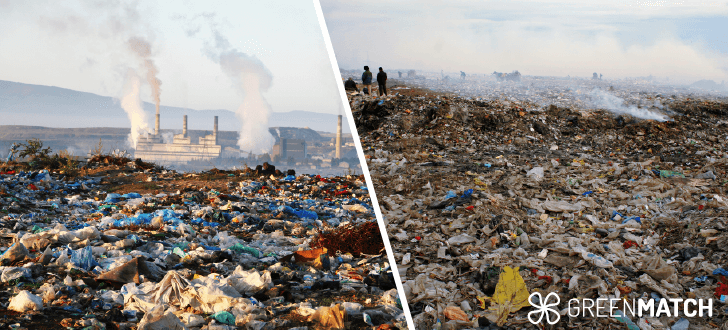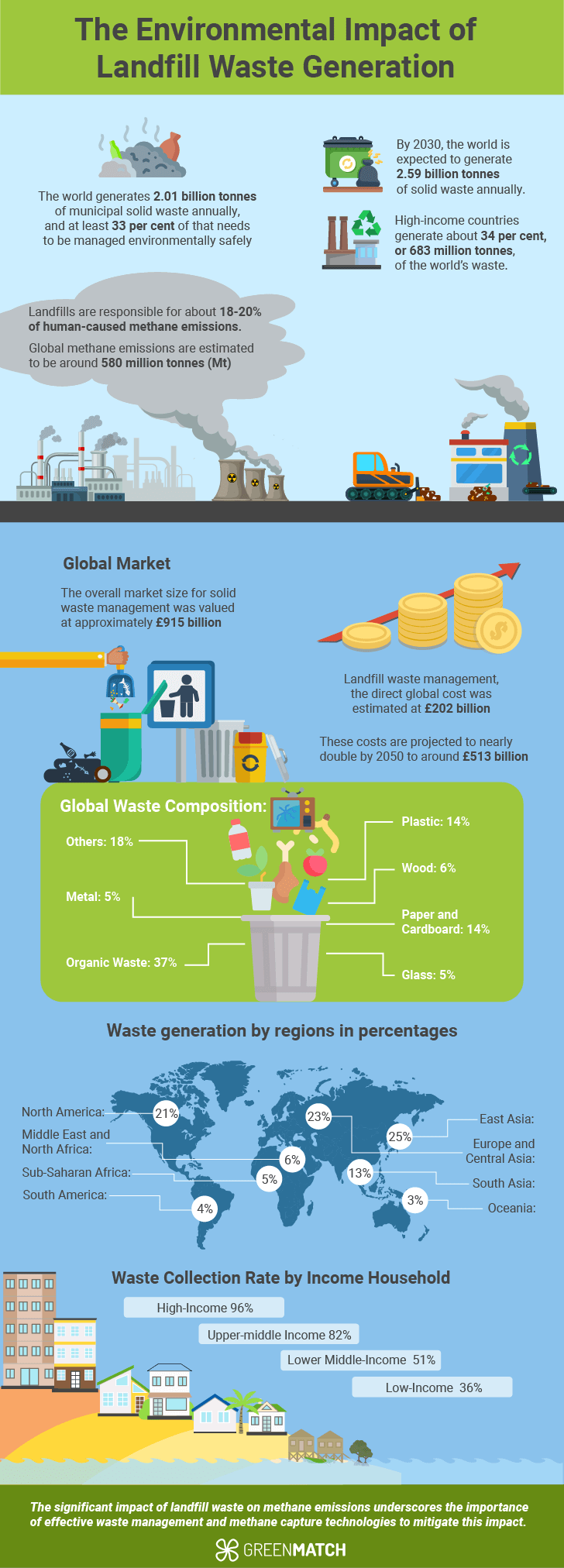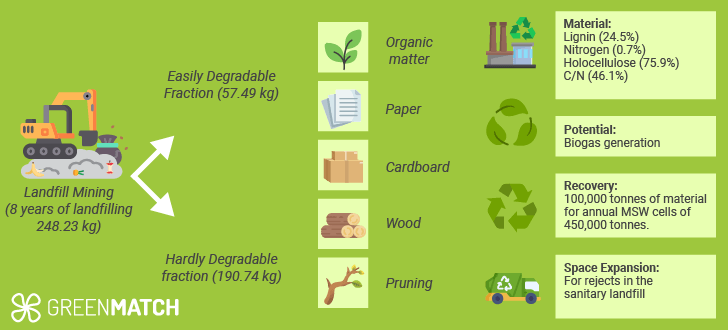
Landfills are a significant source of methane, a potent greenhouse gas 84 times more effective at trapping atmospheric heat than carbon dioxide over 20 years. Methane emissions from landfills contribute significantly to global warming and climate change.
It is notorious for its adverse environmental effects, including greenhouse gas emissions, soil and water contamination, and natural habitat destruction.

Heavy metals and other pollutants in landfill waste can lead to soil contamination, reducing its fertility and altering its chemical composition. This not only affects plant growth but also impacts the broader ecosystem services that healthy soil supports.
The UK faces a potential landfill capacity crisis, with existing sites nearing full capacity and new sites difficult to establish due to public opposition and environmental concerns. The Environmental Protection Agency (EPA) states that landfills are the third-largest source of methane emissions in the United States, contributing a whopping 14.8% in 2021.
The journey from realising the gravity of landfill effects to finding sustainable solutions introduces many considerations, including methane emissions, landfill gas, and the overarching environmental impact. This article explores these critical topics, offering insights into why landfills harm the environment.
What Do We Mean by Landfills Exactly?
Landfills, in the simplest terms, refer to disposing of large amounts of rubbish by burying it or where this disposal occurs. This method of waste disposal is one of the oldest and most common globally. The term ‘landfill’ often brings to mind municipal or sanitary landfills, scientifically designed sites where waste is systematically buried.
These facilities are constructed to minimise the environmental impact by controlling emissions of gases, liquids, and solid materials.

Landfills pose significant environmental risks. They are sources of methane, a potent greenhouse gas, and can lead to groundwater contamination through leachate. Composing waste in landfills contributes to air pollution and can affect local biodiversity.
| Region | Total Waste Generated (tonnes/year) | Percentage Sent to Landfill |
|---|---|---|
| Asia | 1 billion | 49% |
| North America | 289 million | 52% |
| Europe | 221 million | 23% |
| Africa | 125 million | 64% |
| South America | 160 million | 57% |
Properly managed plays a critical role in waste management by ensuring that the gases produced during the decomposition of waste are either flared or recovered for energy generation. In some countries, extensive landfill gas recovery contributes to cleaner energy production by generating electricity.
Types of Landfills
- Municipal Landfills: Typically referred to by the shorthand ‘landfill’, these are meant for everyday waste disposal from households and businesses.
- Sanitary Landfills: These are designed as biological reactors where microbes degrade organic waste into more straightforward, less toxic compounds over time.
- Solar Landfills: Innovative use of closed landfills, repurposed as solar farms, harnessing solar energy on previously used land.
Environmental Impact of Landfills
Landfills contribute to local weather change by methane emissions. As natural waste decomposes anaerobically in landfills, it releases methane into the environment, exacerbating world warming.
Additionally, landfills produce leachate, a poisonous liquid that may contaminate groundwater and floor water, posing dangers to ecosystems and human well being. In the UK, landfills contribute 27% of whole methane emissions, highlighting waste administration’s important position in nationwide greenhouse fuel profiles.
Besides methane, landfills emit carbon dioxide, water vapour, hint quantities of oxygen, nitrogen, hydrogen, and non-methane natural compounds. These emissions contribute to local weather change and smog, exacerbating air high quality points.
In areas with stringent waste administration rules, such because the European Union and elements of the United States, the environmental affect is mitigated by applied sciences like methane seize and strict regulatory frameworks. However, in lots of growing international locations, open dumps are widespread, and the ecological administration of landfills is much less managed, resulting in extra extreme environmental degradation.

This illustrates the distribution of methane emissions from landfills throughout key world areas, highlighting the numerous contribution to world greenhouse fuel emissions.
What is so dangerous about Landfill for the setting?
- Methane and Other Greenhouse Gas Emissions: As organic waste decomposes anaerobically in landfills, it releases methane into the atmosphere, exacerbating global warming.
- Impact on Water and Soil: Leachate, a toxic liquid that forms when waste breaks down in the landfill and water filters through that waste, poses a severe threat to water quality. It can leak and contaminate nearby water sources, leading to eutrophication and creating “dead zones” where no life can exist. The mix of toxic substances and decaying organic material in landfills can significantly distort soil fertility and activity, negatively affecting plant life.
- Biodiversity and Habitat: The creation of landfills leads to significant habitat loss. The average landfill size in the United States is 600 acres, contributing to substantial ecological disruption. The presence of landfills can destroy wildlife habitats and attract large amounts of rodents, impacting local businesses and communities. Additionally, coastal landfills are at risk of flooding and erosion, threatening marine life.
- Toxic Chemicals: PFAS, known as “forever chemicals”, is found in landfill leachate. It persists in the environment and has been detected at levels up to 260 times higher than England’s current guidance for safe drinking water levels.

What is the affect of Landfill?
Total affect per yr
Globally, landfills emit roughly 1.6 billion tonnes of carbon dioxide equal greenhouse gases yearly. This accounts for about 5% of worldwide emissions, pushed primarily by waste disposal in open dumps and landfills with out fuel assortment methods.
Impact per day
Daily, the world generates 2.01 billion tonnes of municipal stable waste yearly, with a good portion ending up in landfills. This equates to roughly 5.5 million tonnes of waste being landfilled day by day, contributing to the continual launch of methane and leachate manufacturing.
Impact per utilization
For each tonne of waste in a landfill, there’s a missed alternative for recycling or composting, which may considerably cut back environmental impacts. For occasion, recycling textiles as a substitute of landfilling them may forestall the emission of three.6 tonnes of CO2 per tonne of textile waste.
Top Largest Economies Contributing to Landfill
Landfills stay a big environmental problem, exacerbated by the waste administration practices of a number of the world’s largest economies. This part delves into the international locations that contribute notably to landfill volumes, highlighting their present practices and the pressing want for extra sustainable waste administration options.
- United States: A Leading Contributor
The United States is the biggest world waste producer, with every citizen producing roughly 811 kg yearly. About half of this waste is in landfills, contributing to important methane emissions and different environmental hazards.
- China: Industrial Growth Leading to Increased Waste
China’s industrialisation and urbanisation have led to elevated waste manufacturing. Although recycling initiatives are in place, the dimensions of waste technology overwhelms present administration capacities, leading to important landfill use.
- European Union: High Waste Production with Robust Management
In the European Union, stringent waste administration rules assist mitigate the affect of excessive waste volumes. For occasion, the EU’s Landfill Directive goals to cut back landfill use by selling recycling and incineration. Despite these efforts, substantial quantities of waste nonetheless discover their approach into landfills, with variations in compliance amongst member states.
- India: Urban Expansion and Landfill Challenges
Due to city enlargement and restricted recycling infrastructure, India faces vital waste administration challenges. High inhabitants density and fast urbanisation exacerbate the state of affairs, resulting in the proliferation of landfills and elevated environmental dangers.
| Country | Waste per Capita (kg/yr) | Percentage of Waste Landfilled |
|---|---|---|
| United States | 811 | 50% |
| European Union | Varies by nation | Varies by nation |
| China | 520 | 60% |
| India | 500 | 50% |
| Brazil | 380 | 59.5% |
Insights and Global Impact
These international locations, representing a number of the world’s largest economies, play a big position in world landfill contributions. Their waste administration practices and insurance policies considerably affect world environmental well being.
However, a number of international locations are main the best way in lowering landfill use by progressive waste administration methods:
- Germany and Sweden have implemented aggressive recycling and waste-to-energy programs that minimise landfill use.
- South Korea has dramatically reduced food waste through composting initiatives.
By adopting extra sustainable waste administration practices, we are able to mitigate the environmental, well being, and financial impacts.
Statistics, Facts, and Figures About Landfills
- Globally, we generate 2.01 billion tonnes of municipal solid waste annually, with projections indicating a rise to 3.40 billion tonnes by 2050.
- Currently, at least 33% of this waste needs to be managed environmentally safely.
- Despite representing only 16% of the world’s population, high-income countries generate about 34% of the world’s waste.
- Landfills are the US’s third-largest source of human-related methane emissions, contributing to about 15% of these emissions.
- Methane, a potent greenhouse gas, exacerbates global warming.
- Over 267.8 million tons of waste are generated annually in the US, with a significant portion ending up in landfills.
- The UK faces a potential landfill capacity crisis, with existing sites nearing full capacity and new sites difficult to establish due to public opposition and environmental concerns.
- The global waste recycling market is expected to grow, reaching a value of approximately £62 billion by 2027.
- Asia, Europe, and North America lead in waste generation, with Asia topping the list at 468 million tonnes annually.
- Despite advancements in waste management, the global recycling market is valued at £61 billion.
- About 50% of the 230 million tonnes of yearly waste in the United States enters over 2,000 active landfills.
- In high-income countries, only 2% of waste is in landfills; this figure skyrockets to approximately 93 in low-income countries.
The desk under offers a snapshot of waste technology and landfill use throughout numerous areas:

Landfill Impact Statistics
| Country | Annual Waste Generation (tons) | Percentage to Landfills |
|---|---|---|
| USA | 267.8 million | 52% |
| UK | 222 million | 44% |
| Canada | 25 million | 30% |
How Toxic are Landfills for the Environment?
Living close to landfills has been related to a 12% elevated threat of congenital malformations in kids, highlighting the extreme health risks these websites can pose to close by communities.
Moreover, the odours from landfills, attributable to numerous chemical compounds launched as gases, will be detected at poor concentrations. This chemical, a kind of PFAS, is linked to several severe health issues in humans, together with kidney and testicular cancers, hypertension, thyroid illness, and a lowered response to vaccines.
In addition, these amenities produce emissions equal to important lengths of UK motorways. For occasion, oxides of nitrogen from an EfW plant match these produced by a 7km stretch of motorway hourly. Similarly, particulate matter emissions are similar to a 5km length of UK motorway.
Comparative Toxic Emissions from Landfills and EfW Plants
| Emission Type | Equivalent Source |
|---|---|
| Oxides of Nitrogen | 7km of UK motorway (hourly) |
| Particulate Matter | 5km of UK motorway (hourly) |
| Cadmium | One-twentieth of a medium-sized coal-fired station |
| Dioxins and Furans | Accidental fires in a city of 200,000 inhabitants |
How Long Does It Take for Landfill Products to Biodegrade?
Understanding the biodegradation timeline of merchandise in landfills is essential for assessing environmental impacts and bettering waste administration methods. Here, we discover the decomposition charges of on a regular basis waste gadgets, offering a clearer image of landfill longevity and its affect.

Biodegradation Timelines for Common Materials
The charge at which merchandise biodegrade in landfills varies considerably primarily based on the fabric composition and landfill circumstances. Here’s a fast take a look at the decomposition charges for generally discarded gadgets:
- Organic Waste (Food Scraps, Garden Waste): Decomposes within weeks to months but can generate methane, a potent greenhouse gas.
- Paper: Breaks down from 2 to 6 weeks under optimal conditions but can take longer if compacted in a landfill, lacking oxygen.
- Cardboard: Typically degrades within two months but may take longer depending on the landfill’s moisture and oxygen levels.
- Plastics: Conventional plastics can decompose anywhere from 20 to 500 years. Biodegradable plastics may reduce this time but require specific conditions to break down effectively.
- Cans and Metals: These materials do not biodegrade. Glass can last indefinitely, and metals may rust but do not break down into harmless substances. Steel cans and aluminium products are some of the most enduring materials, breaking down from 50 to 500 years.
- Textiles: Natural fibres like cotton and wool decompose relatively quickly, taking about six months and one year. In contrast, synthetic fibres like nylon and polyester are far more persistent, taking 30 to 40 years and over 500 years, respectively.
- Wood and Lumber: Wood from trees, such as stumps and branches, can decompose 50 to 100 years if left whole. Smaller or more processed pieces may degrade at different rates.
- Plastics and Synthetics: Plastics and styrofoam represent significant challenges, with decomposition times exceeding 500 years. This includes everyday items like plastic bags and packaging materials.
- Glass: One of the most durable materials, glass can take 1 to 2 million years to naturally break down in a landfill setting.
Can or not it’s Managed Sustainably?
The world generates over 2 billion tonnes of waste annually. Of this, 37% find yourself in landfills. These websites produce important methane emissions, contributing to local weather change.
Recent developments have launched extra sustainable practices in landfill administration. These embrace enhanced methane seize applied sciences, utilizing biodegradable liners to minimise leachate manufacturing, and integrating photo voltaic panel covers to generate renewable power whereas capping waste.
Countries around the globe are adopting these progressive practices. For instance, the Netherlands has pioneered Sustainable Landfill Management (SLM), utilizing pure processes to stabilise waste supplies, considerably lowering the necessity for long-term care and environmental monitoring.
Also, The European Union has made important strides in waste administration, with landfill charges lowering from 23% to 16% between 2010 and 2020. This discount is a part of a broader shift in direction of a round economic system, prioritising waste prevention, recycling, and restoration over disposal.
| Country | Methane Emissions (Million tonnes) | Sustainable Practices Adopted |
|---|---|---|
| USA | 1.2 | Methane Capture, Recycling |
| Netherlands | 0.3 | Sustainable Landfill Management (SLM) |
| India | 0.9 | Methane Capture, Community Engagement |
| UK | 0.4 | Recycling, Waste Reduction Programs |
Looking forward, the main target is shifting in direction of lowering landfill use by elevated recycling and waste discount methods.
Environmental Impact Compared to Everyday Things
Landfills should not simply eyesores; they’re important sources of CO2 emissions. When natural waste decomposes in landfills, it releases methane, a potent greenhouse fuel. Methane has a world warming potential 28 occasions better than CO2 over 100 years.
This means landfills may generate about 1,300 million metric tons of CO2 yearly worldwide. This is equal to the emissions from over 24 million gasoline-powered automobiles or the annual power use of greater than 13.1 million homes. This huge determine typically goes unnoticed, overshadowed by extra seen sources of air pollution.
But how do these emissions stack up in opposition to on a regular basis gadgets and actions we regularly overlook?
To put landfill emissions into perspective, let’s evaluate them with on a regular basis gadgets and actions:
- Driving a Car: The average petrol car emits about 2.31 kg of CO2 per litre of fuel burned. Considering the average car fuel consumption is about 7.6 litres per 100 kilometres, a 10 km trip releases approximately 1.75 kg of CO2.
- Electricity Consumption: The average household electricity consumption in the UK emits about 0.233 kg of CO2 per kWh. Watching TV for 3 hours a day annually emits roughly 255 kilograms of CO2.
- Flying: A single flight from London to New York emits approximately 986 kg of CO2 per passenger.
In the UK alone, landfills emitted roughly 22 million tonnes of CO2 equal. When evaluating these figures to landfill emissions, the dimensions turns into obvious. Landfills contribute extra to world CO2 ranges than most day by day actions mixed. This stark distinction highlights the pressing want for waste administration reform and improved recycling efforts.
What Are Alternatives to Landfill?
Landfills dominate waste administration, however viable options exist. These choices cut back environmental affect and promote sustainability.
Here are a number of the only options:
- Recycling
- Why It’s Better: Recycling converts waste into reusable materials. It reduces landfill waste, conserves resources, and lowers greenhouse gas emissions.
- Example: Germany recycles 67% of its waste, leading the world in efficient waste management.
- Composting
- Why It’s Better: Composting organic waste produces nutrient-rich soil. It decreases landfill input and cuts methane emissions.
- Example: San Francisco composts 80% of its organic waste, supporting local agriculture.
- Incineration with Energy Recovery
- Why It’s Better: Incineration reduces waste volume by 90% and generates energy. Modern plants control emissions effectively.
- Example: Sweden incinerates waste to produce heat and electricity for thousands of homes.
- Anaerobic Digestion
- Waste-to-Energy (WtE)
- Why It’s Better: WtE plants burn waste to generate electricity. This method reduces landfill dependence and produces renewable energy. However, they use advanced technology to capture the energy produced during waste combustion efficiently.
- Example: Denmark’s WtE plants supply power to 500,000 homes, cutting landfill use drastically.
| Alternative | Waste Processed (Million Tonnes) | Greenhouse Gas Emission Reduction (%) | Energy Produced (MWh/yr) | Investment in Technology (GBP Billion) |
|---|---|---|---|---|
| Recycling | 500 | 60 | N/A | 12 |
| Composting | 300 | 50 | N/A | 5 |
| Incineration with Energy Recovery | 200 | 70 | 15,000,000 | 10 |
| Anaerobic Digestion | 150 | 65 | 10,000,000 | 7 |
| Waste-to-Energy (WtE) | 250 | 75 | 20,000,000 | 15 |
Is Landfill Better Than Its Alternatives?
Landfills are just like their options when contemplating environmental affect. Alternatives like incineration, composting, and recycling provide important benefits:
- Reduced greenhouse gas emissions: Alternatives like incineration and composting emit fewer greenhouse gases than landfills, producing methane, a potent greenhouse gas.
- Energy production: Methods like incineration and WtE generate energy from waste, something landfills cannot achieve.
- Resource recovery: Recycling and MRFs allow for the recovery and reuse of materials, reducing the need to extract new raw materials and conserving natural resources.
Given these factors, options to landfills mitigate environmental harm and supply extra advantages like power manufacturing and useful resource conservation, making them superior choices for waste administration.




